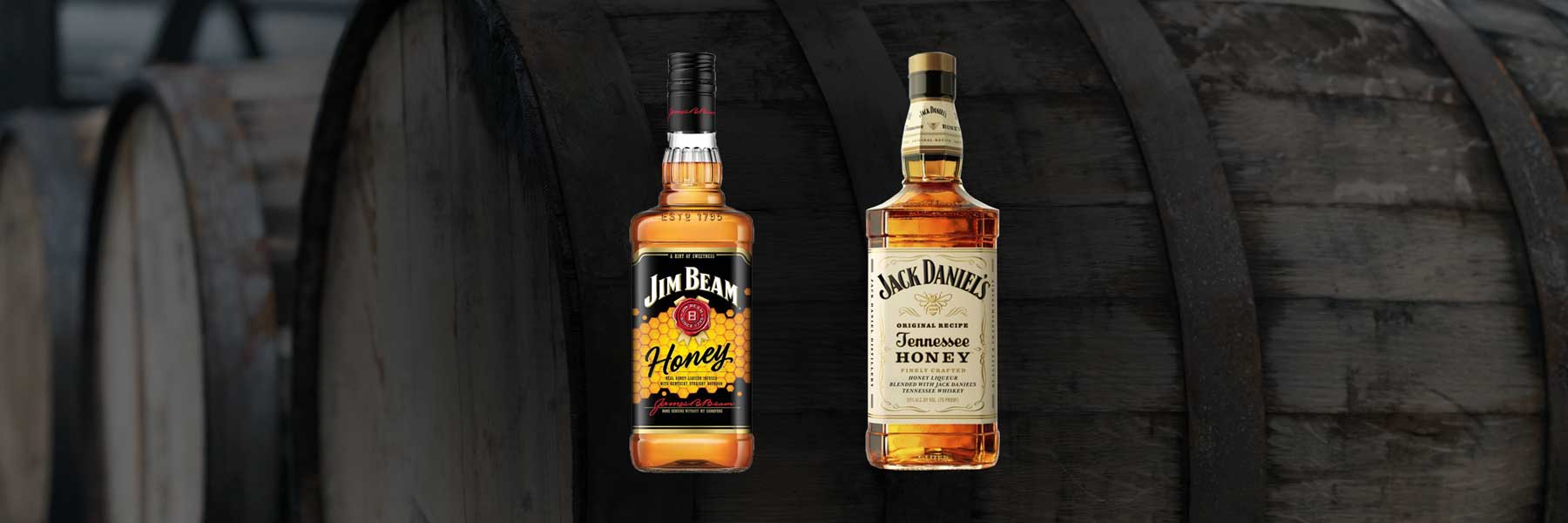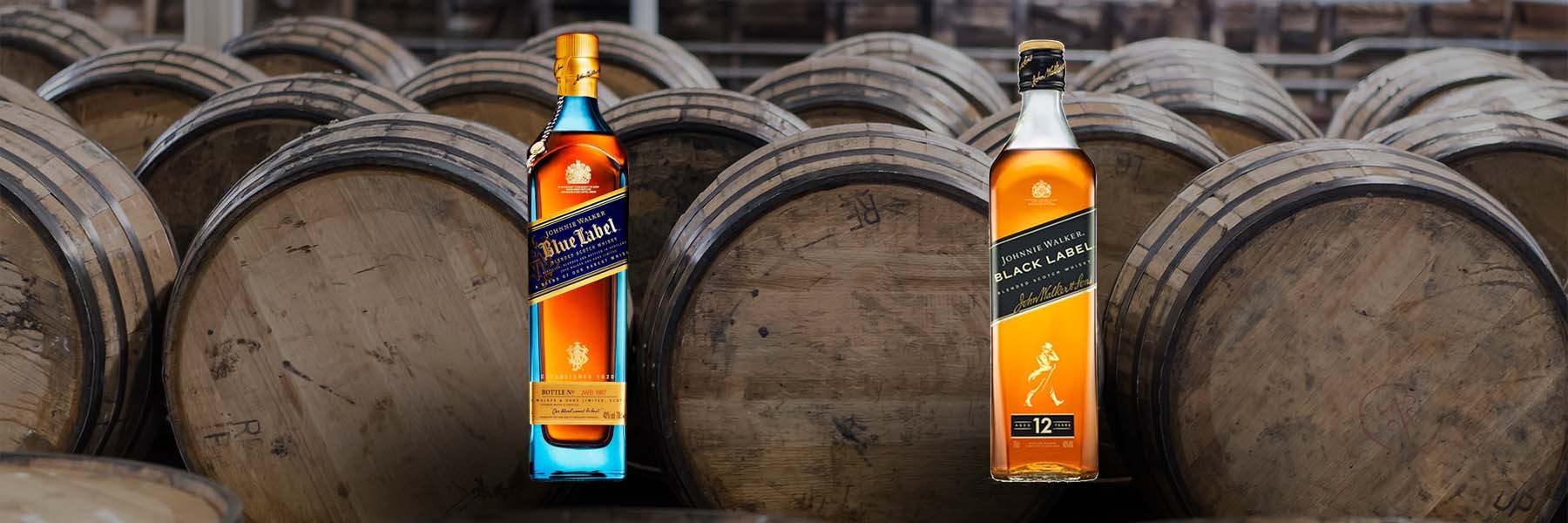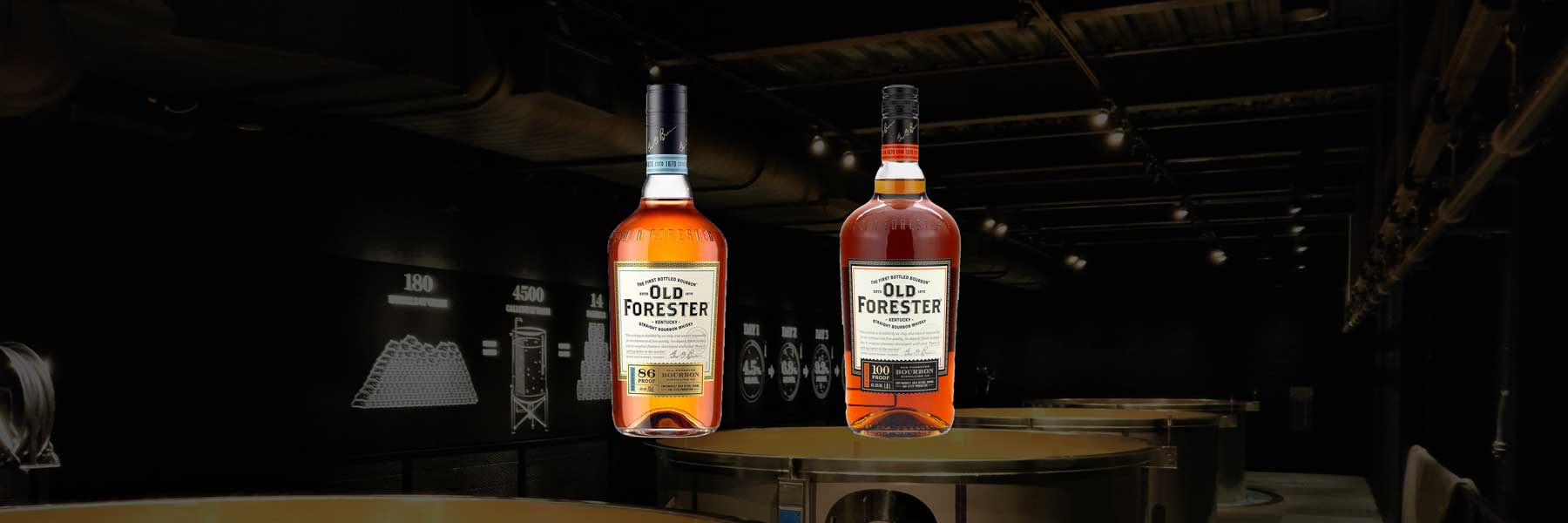Jim Beam vs Four Roses | Comparing these bottom shelf bourbons
For guilt free, daily sipping, you want a go-to whiskey you can affordably rely on. A drinks-shelf mainstay that’ll never let you down, right?
Whether you’re a long term connoisseur, or you’re just getting started, this article will compare two of the most popular low shelf bourbons on the market.
Yep, they might be cheap. But let’s see which gives the biggest bang for buck when you weigh up Jim Beam vs Four Roses signature bourbons.
Let’s dive in.
Quick brand overview
Jim Beam was founded in 1795 with their distillery based in Clermont, Kentucky. Their whiskeys are sold as Kentucky straight bourbon with 6 core-range bottles in their repertoire, including their world famous ‘White Label’. With 6.4 million cases sold in 2021, Jim Beam are consistently the top selling bourbon brand in the world.
Four Roses was founded in 1884 with their distillery based in Lawrenceburg, Kentucky. Their whiskeys are sold as Kentucky straight bourbon with 4 core-range bottles in their repertoire, including their entry level, colloquially known ‘Yellow Label’. In the bourbon market, they’re known for their unique 10 recipe system which uses 2 proprietary mashbills and 5 yeast strains.
Jim Beam vs Four Roses
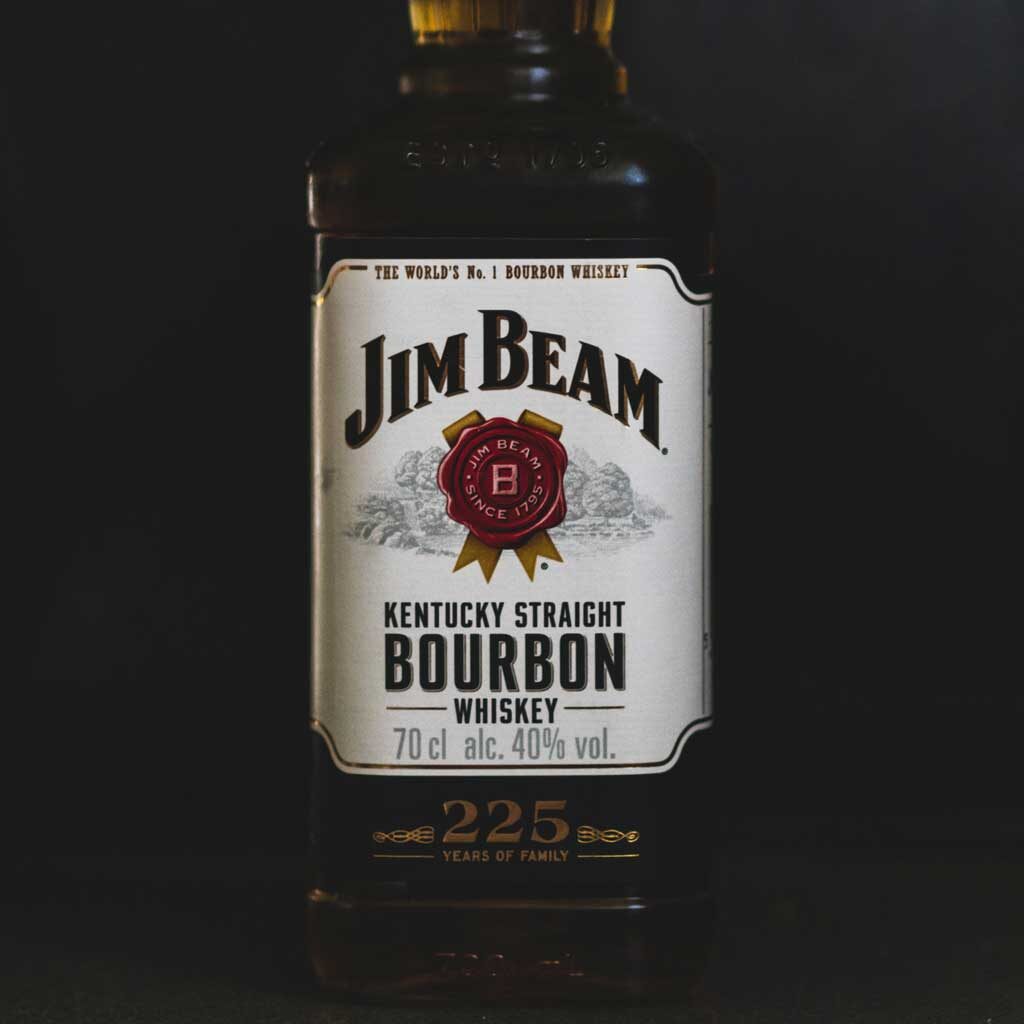
Jim Beam White Label
Nose: Hay, vanilla, oak & wood.
Palate: Spiced, sweet with toasted oak, crème anglaise, acetone.
Mouthfeel: Rich and full-bodied.
Finish: Medium to long finish with lingering sweet woody notes.
Age: NAS (4 years minimum)
Region: Clermont, Kentucky
Barrels: Charred, new American oak barrels
Chill filtered: Yes
Mashbill: 75% corn, 13% rye & 12% malted barley.
Strength: 86 proof / 43% ABV
Price: £20 / $25
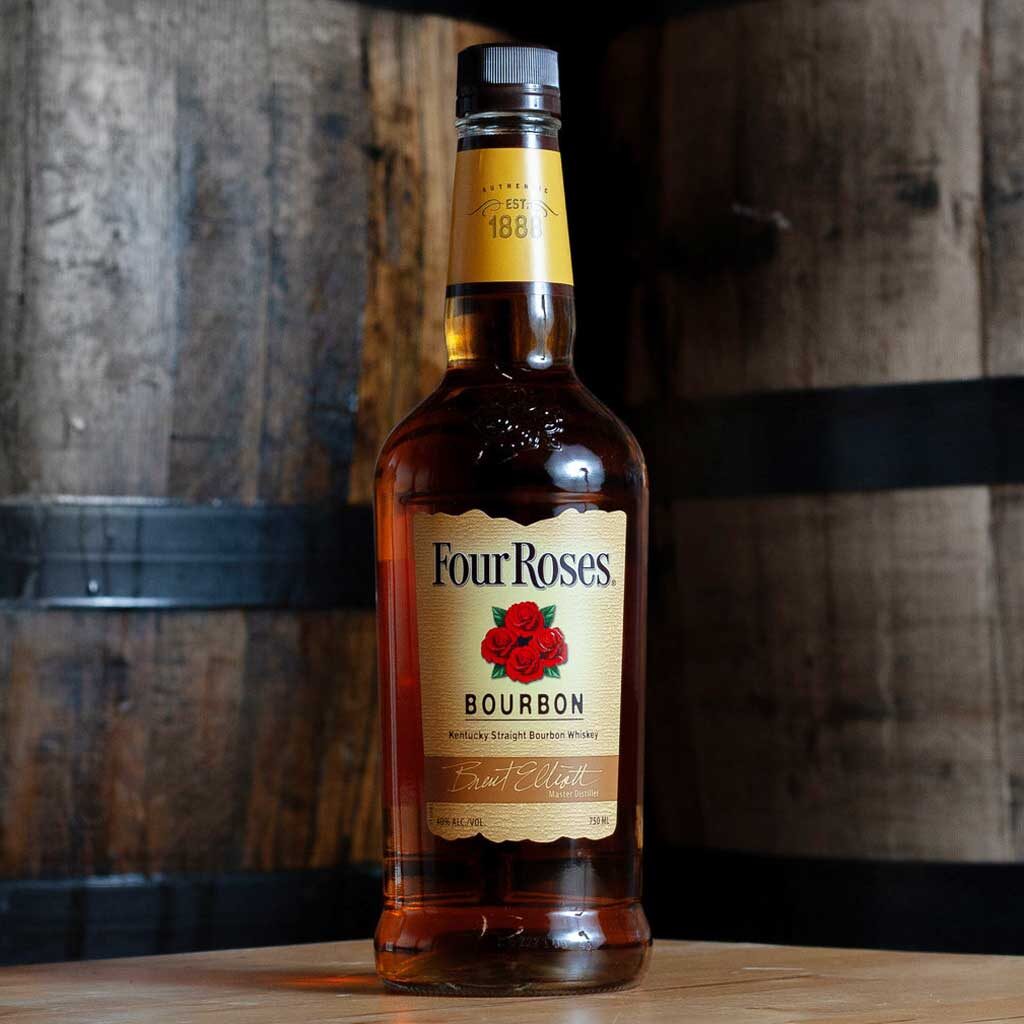
Four Roses Yellow Label
Nose: Caramel, marmalade & orange
Palate: Honey, lemon, oak & marmalade
Mouthfeel: Rich & thick
Finish: Medium finish with a spicy & sweet aftertaste.
Age: NAS (5 years minimum)
Region: Lawrenceburg, Kentucky
Barrels: Charred, new American oak barrels
Chill filtered: Yes
Mashbill: Dual mashbill (Grain recipe ‘B’ & ‘E’.
Strength: 80 proof / 40% ABV
Price: £24 / $30
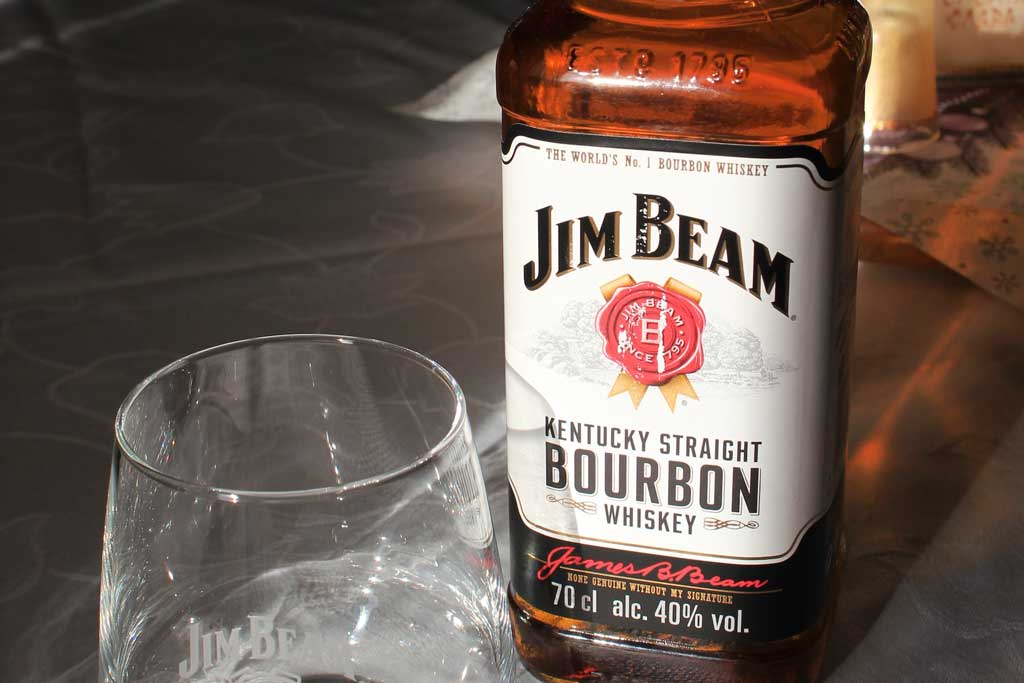
A closer look at Jim Beam White Label
White Label is Jim Beam’s entry-level bourbon. Aged for twice as long as legally required, it’s got a reputation as one of the smoothest low-shelf options for less than $25 / £20. As the world’s most popular bourbon, it’s a usual-suspect on back bars around the world and is commonly used for cocktail making or mixing. Interestingly, it’s also the most popular bourbon in Japan and can be bought in almost any convenience store.
Like most Kentucky bourbons, Jim Beam uses the sour mash method to make their White Label Bourbon. If you enjoy a spicy whiskey, it’s got an undisclosed, relitively high-rye mashbill of around 75% corn, 13% rye & 12% malted barley.
Before I delve into the tasting notes, it’s worth mentioning the distillation method for this bourbon. White Label is known for it’s incredibly smooth profile with very little harshness. This due to how they make their raw ‘white dog’ spirit. To achieve this, the bourbon is double distilled, first using an enormous 65 foot tall column still and then a secondary doubler still. This is done at lower than average temperatures which avoids boiling the beer during distillation. A comparatively gentle approach, this produces a lower proof (125) new make spirit helping retain maximum flavour and the gentle mellowness their bourbons are known for.
Nose: Opening the iconic square bottle, Jim Beam White Label has an immediately sweet, inviting smell. But that’s just with the lid off, so after pouring it, I left it for around 10 minutes to help it breathe and open up.
Using a rocks glass for this bourbon (why not?) I can smell freshly-cut hay, with undertones of vanilla, oak and wood. There’s also a background aroma of nuts, which as a peanut butter fiend, I’m totally cool with. So far, the nose is pretty light but good and is actually better than what I expected.
With a little swirling, I get more cereal sweetness, mixed with more honey. There’s also some fruits in there like apple and orange, mixed with a little spice like cinnamon and clove. Maybe a touch of liquorice in there too. Accumulatively, this is really quite a pleasant and available aroma.
Palate: Taking my first sip, a wave of nutty sweetness washes over the tongue. Strong oak and woody notes are present, followed by an creamy undertone of crème anglaise. Strangely, the initial flavours aren’t quite what the smell had promised – they don’t seem to match what the nose offers which feels somewhat disjointed.
Further in, the flavour becomes oaky, earthy and actually kind of ‘drying’. So far, it feels a little thin and somewhat reluctant in the more delicate notes of florals and herbs. Perhaps it’s the age of this bourbon that’s holding these flavours back, which seem to be relitively faint on the palate.
Congruous to the hype, I don’t find this bourbon harsh at all. At 86 proof (43% ABV) it is indeed very smooth and there’s certainly no water needed. It’s also pleasantly sweet with a cheerful hum of cinnamon and tangy vanilla. Kind of what you’d expect really. Nothing that surprising or particularly memorable. It’s easy to sip… and that just about it.
Mouthfeel: Jim Beam White Label has a decidedly thin texture. There’s certainly a youthful, oaky element going on which gives this drying sensation in my mouth. The nuttiness is mildly oily, but not thick or heavy at all.
Finish: The finish is mid-length. It lingers nicely with a hint of cereal sweetness and toasted oak flavours that stick around for quite some time. There’s also a light butterscotch note that appears before the whiskey fades away completely. With more sips, it just seems to get progressively more dry which is a shame. Overall, it’s an ‘okay’ finish which you’d expect from a bourbon of this price.
Price: Jim Beam White Label is an accessible, wallet-friendly bourbon that offers good value for money. It typically retails for around $20 – $25 a bottle in most US states, which makes it easier to enjoy on a more frequent basis. In the UK, the price is roughly £18 – £22 depending on where you buy it from. Considering the high-volume nature of this top selling of this bourbon, it’s suitably affordable.
At 86 proof (43% ABV) with a mellow and smooth profile, I believe Jim Beam White Label is an ‘alright’ option for everyday sipping without breaking the bank. If you’re looking to venture into bourbon without wanting to spend too much money, it’s an easy and obvious choice. For more seasoned bourbon drinkers, I wouldn’t really recommend it.
Obviously, the flavour profile isn’t anywhere near as complex or intense as premium bourbons out there, but it still has reasonable flavour. Personally, I’d use it for mixing or for bourbon based cocktails instead of drinking it neat.
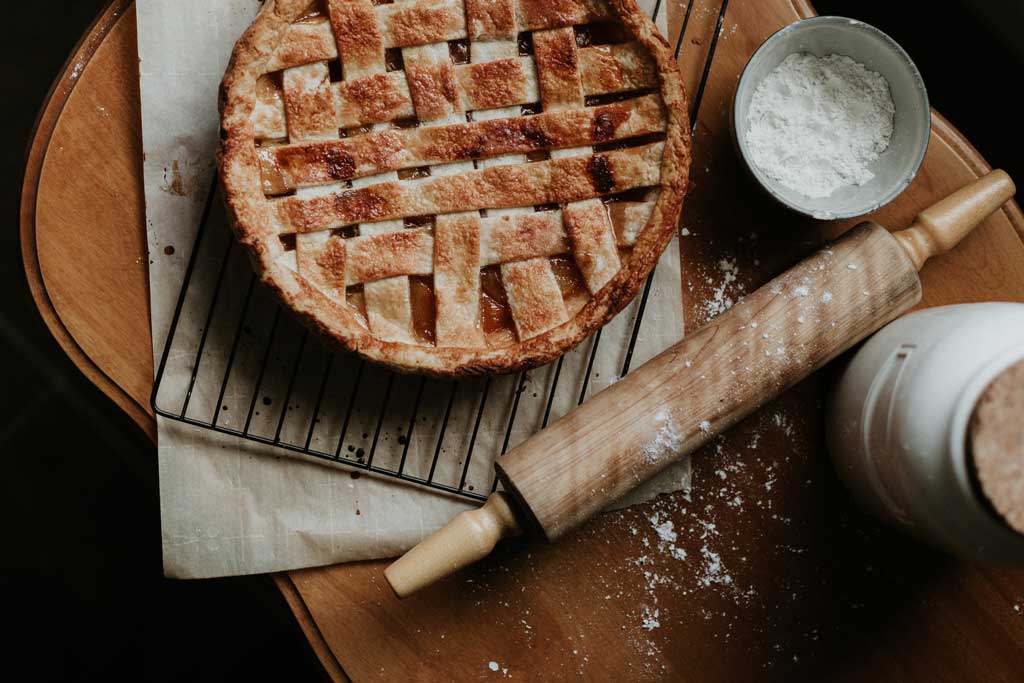
Jim Beam food pairings
Jim Beam white label bourbon pairs well with all sorts of appetizers, entrees, and desserts. To start things off, an appetizer of a creamy pimento cheese dip served with spicy crackers would be delightful. The sharp taste of the cheese and spice contrasts nicely with Jim Beam’s mellow flavour. Alternatively, a light charcuterie board featuring cured meats and cheeses is also a great match for this smooth sippin’ bourbon.
For mains, smoked pork chops are a great match for Jim Beam white label. The smokiness of the dish contrasts nicely with the sweet notes in the whiskey. A slow-roasted rack of lamb marinated in herbs and garlic is another excellent pairing; when enjoyed together, these two flavours make for an amazing combination that lingers on the palate long after they’re gone.
Finally, what goes better with whiskey than dessert? A classic apple pie topped with vanilla ice cream or crème fraiche makes a wonderful end to any meal paired with Jim Beam white label bourbon. The sweetness of the pie and ice cream pair perfectly with the earthy notes in the whiskey. For something more contemporary and complex, try making a whiskey-infused chocolate truffle tartlet; this luxurious dessert matches wonderfully with this bourbon’s nutty aroma and smooth taste.
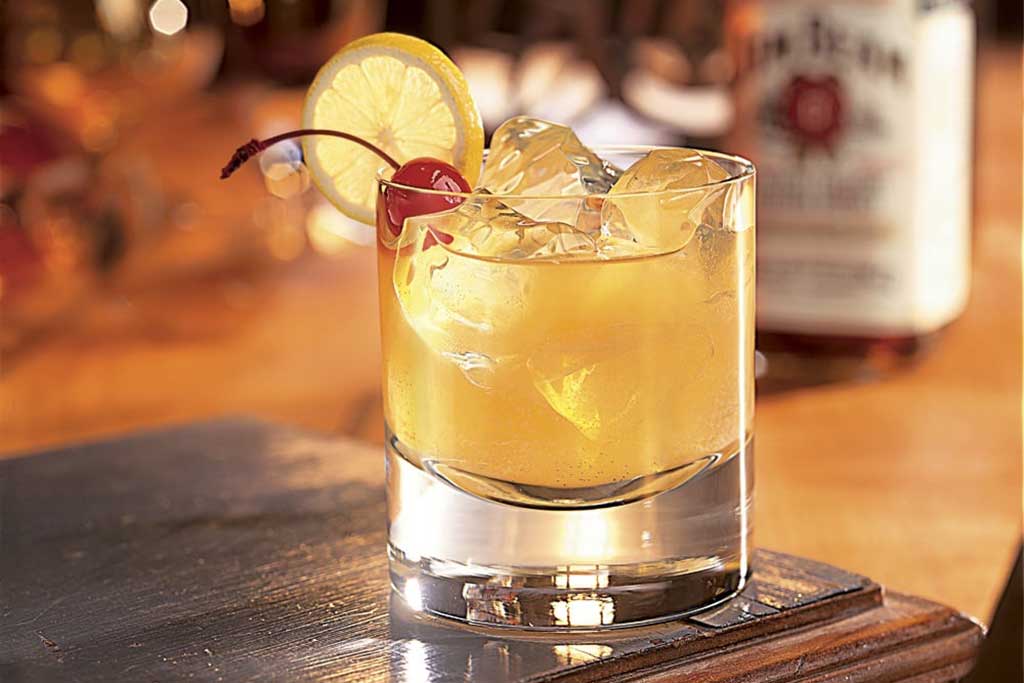
Jim Beam cocktail suggestion
Jim Beam is the perfect bourbon for making a whiskey sour cocktail due to its smooth, mellow flavour profile and accessible price point. Its subtle hints of cinnamon and vanilla make it an exceptionally tasty choice for creating this classic cocktail that’ll please any palate.
Ingredients
- 50ml Jim Beam
- 25ml Lemon juice
- 125ml Lemon soda
- 12ml simple syrup
- Lemon wedge
- Cherry
Method
Into an ice-filled cocktail shaker, measure-in your bourbon, lemon juice and syrup. Shake vigorously for 10 seconds before straining into a rocks glass. Top with the soda and garnish with a slice of lemon and skewered cherry. Serve.
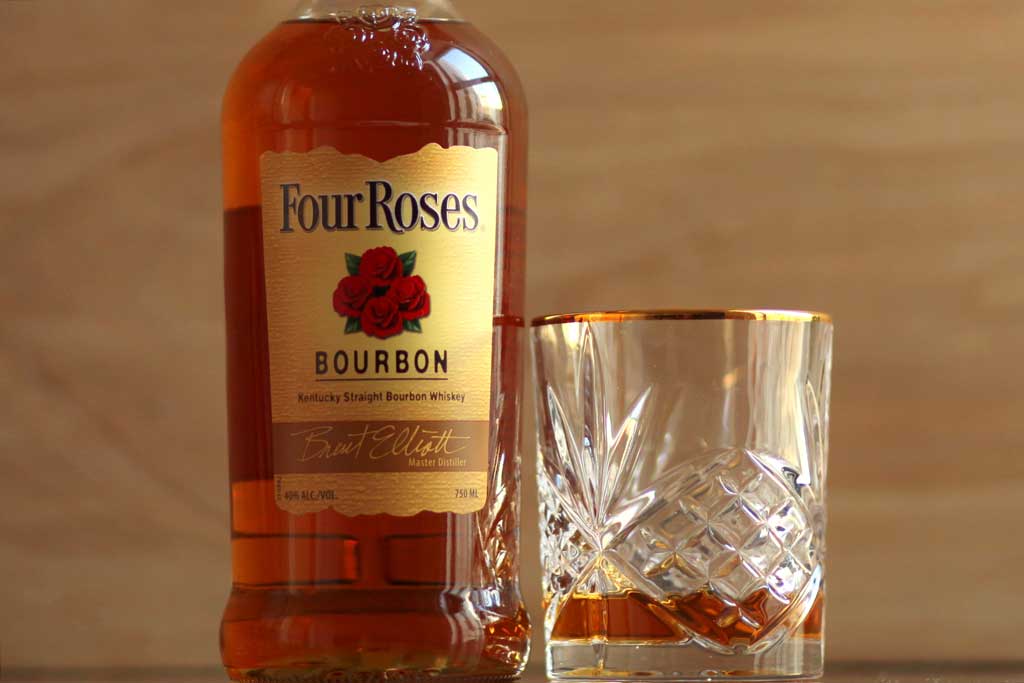
A closer look at Four Roses Yellow Label
Next up is the Four Roses Bourbon, often informally known as ‘Yellow Label’. As their entry level expression, it’s the most affordable amongst their core-range of four bottles. If you’re unfamiliar with this Kentucky brand, it’s worth delving into their rather unique 10 recipe system, which coincidentally, each of which is used to make this signature edition of their bourbon. Let me explain…
To make their whisky, distilleries often use one or two grain recipes (mashbills) and some kind of sacred and very brand-specific type of yeast. Four Roses however, use two mashbills and five types of yeast to make ten uniquely flavoured bourbon recipes, each with their own individual code.
Depending on the whiskey being made, they blend certain bourbon recipes to create a particular flavour profile. Their Yellow Label bottle uses all ten recipes, whilst their Small Batch uses four. For obvious reasons, their single barrel uses just one recipe from one barrel.
As their signature expression, Yellow Label balances a high rye mashbill with a slightly sweeter, more traditional mashbill across all 5 yeast strains. This makes it their most rounded bottle, using a wide variety of flavours within its blend.
Naturally, it’s intended to be easy drinking and affordable, made from the widest range of barrels within their warehouse. Certainly not a small batch bottling, it’s a ‘bread and butter’ house blend that’s super affordable. Let’s see how it stacks up to the Jim Beam.
Nose: Freshly opened, the bottle emits sweet and creamy aromas. Like the Jim Beam, it’s got a nice promise of good things to come. (We’ll see!) After pouring it into my glass, there’s a much stronger bouquet of orange, vanilla, lemon zest, and caramel – as if they were freshly-baked into a pastry. A subtle earthy note also flatters the nose with its presence, reminiscent of dry wheat fields in summertime. So far, the nose is certainly appealing
Further into my glass, a faint oakiness appears with a herbal sort of smell. With a little swirling, I get more fresh herbs of mint, dill and thyme. With each inhale, these captivating scents grow stronger, providing a pleasant and inviting introduction to this whiskey.
Palate: My first sip of Four Roses Bourbon confirms honey sweetness that lingers on the tongue. Compared to nose, there’s much more fruit with flavours of cooked apple and pear coming through. Harmoniously, the earthy notes of cinnamon and toasted oak work nicely with this fruitiness, which presumably comes from the rye grain within.
Like the Jim Beam, it’s still relatively smooth and doesn’t need any dilution from ice or water. I don’t get much harshness, however, the overall body and character feels pretty thin and not particularly deep. Again, I think the age of this bourbon sort of lets it down as the flavours feel a little flat and underdeveloped.
Similar to the nose, herbal notes come through with fruity, almost tropical flavours. More honey, orange and lemon with a touch of spice. Overall, it’s a passable drinking experience. Just not particularly compelling or memorable.
Mouthfeel: For me, Four Roses has a light yet creamy texture. There isn’t much body and it feels relitively light, which is likely due to its low proof. This makes it an easy drinker and appropriate for sipping neat.
On the palate, it has a slight tingle in my mouth, probably due to the higher rye grain content within its mashbill. As I savour each sip, it’s pleasant and not overly harsh on my tastebuds – there’s just enough spicy oomph without being overwhelming. It feels pretty smooth going down too, but again this would be aided by lower alcohol content than other bourbons.
Overall, the mouthfeel of Four Roses Bourbon is pleasant and enjoyable. Its gentle character makes this a good entry-level whiskey for those just getting into bourbon drinking – without having to be overpowered by more intense flavours like we find in higher proof expressions.
Finish: The finish of Four Roses Bourbon is relatively simple and restrained. It starts with a subtle sweetness, which gradually morphs into light oak and spiced notes. I can still taste the delicate herbal notes that were present on the nose, as well as some fruity citrus characters. The finish isn’t overly long, but there’s still enough flavour to linger in the mouth after each sip. Overall, Four Roses Bourbon has a pleasant finish. It’s smooth and easy-drinking without being overly sweet or intense.
Price: Yellow Label is reasonable entry-level bourbon and one that won’t break the bank. At around $25-$30 for a 750ml bottle, it’s an affordable option for those wanting to explore the world of bourbon without having to fork out for more expensive labels. For the money, you get a basic dram with a nice aromas and your classic bourbon flavours.
By any means, this bottle doesn’t punch above it’s weight and isn’t overly special, but it is easy to drink and would make a good low-cost daily dram. Being a low proof expression makes it easy to drink, yet it still has enough character to make your taste buds dance. So whether you’re on a budget or just want something simple, Four Roses has you covered.
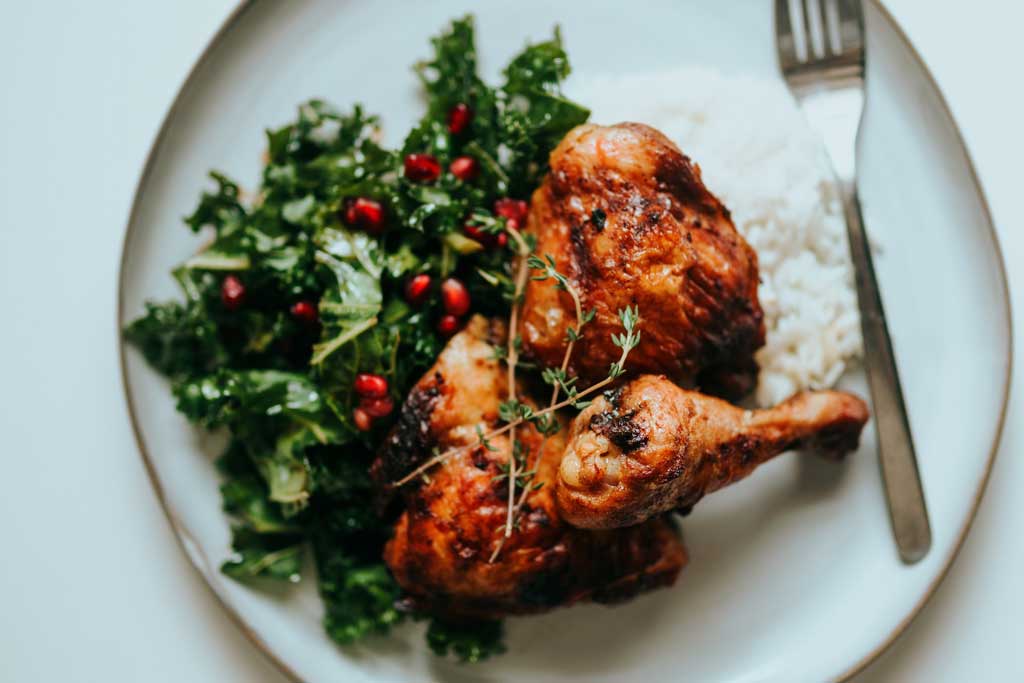
Four Roses Bourbon Food pairings
Four Roses bourbon is a light and approachable whiskey that goes well with a variety of dishes. For starters, its herbal and fruity notes are especially complementary to salads, cured meats and smoked fish. The sweetness of the bourbon pairs perfectly with bitter greens like rocket or radicchio, while the subtle spiciness from the rye grain will add a gentle warmth to any dish.
For mains, Four Roses is an ideal accompaniment to poultry dishes as its softer character will not overpower the delicate flavours of chicken or turkey. Its subtle sweetness can also be used to balance out stronger dishes such as beef brisket or pulled pork, while its herbal notes will be further enhanced by smoky barbecue sauces.
For dessert, Four Roses is a great partner for creamy pastries and puddings. Its lightness means it won’t overpower sweeter desserts such as apple tarts or sticky toffee pudding, while the fruity notes in the bourbon can bring out different flavours in cakes like carrot cake or gingerbread.
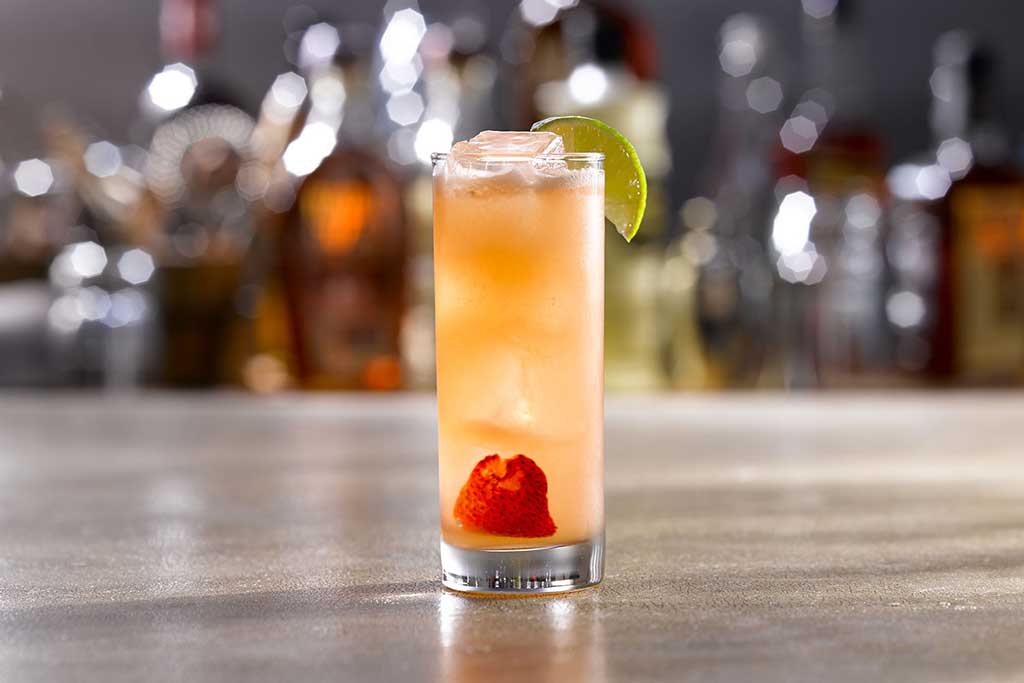
Four Roses Bourbon cocktail suggestion
The Kentucky Buck is a delicious cocktail made with Four Roses bourbon. It has a blend of sweet and sour flavours that go perfectly with this bourbon’s fruity character. Chill a tall Collins or highball glass with some ice and follow this easy cocktail recipe.
Ingredients
- 50 ml Four Roses Bourbon
- 25ml Lemon juice
- 1 tbsp Strawberry Pieces
- 1 dash of Angostura bitters
- Ginger Beer
- Lemon
Method
In an ice-filled cocktail shaker, add the bourbon, lemon juice, strawberry pieces and bitters. Shake and strain into a tall Collins glass. Top with ginger beer and garnish with a wedge of lemon for that added zest. Serve.
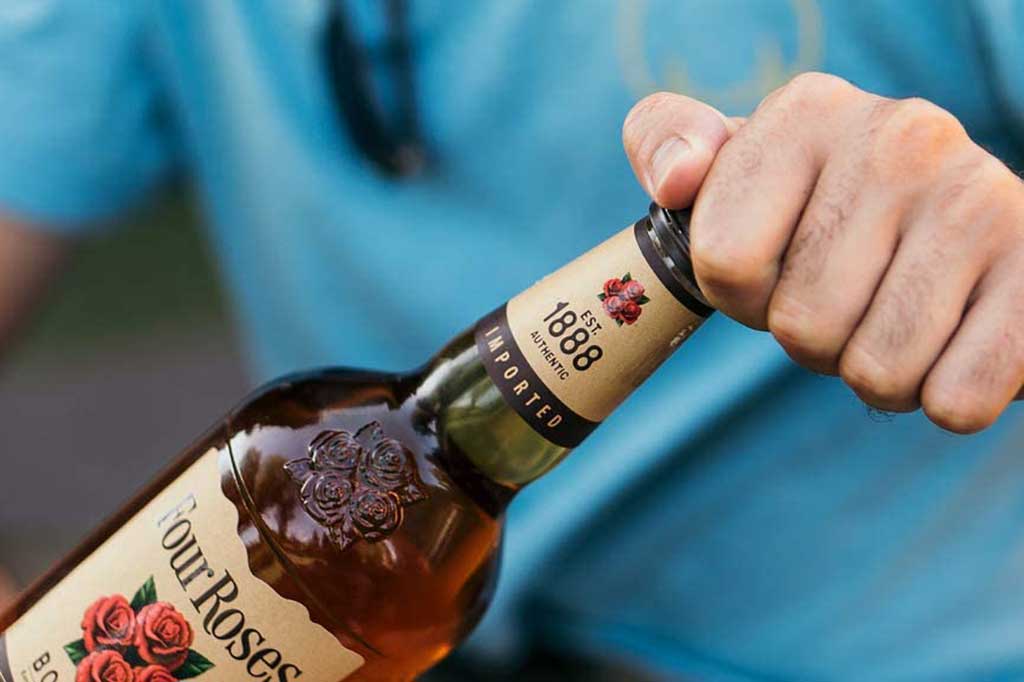
Final thoughts
The Jim Beam met all expectations. It was smooth, simple and delivered the typical sweet and spicy flavours you’d expect from an entry-level bourbon. Admittedly, the nose was better than the taste, which felt thin and underwhelming. It was easy to drink neat, but had a young, oaky dryness that let the overall flavour down. Not a bad bourbon, just simple, sweet without much character.
The Four Roses was also really quite smooth. No harshness to report with a fruity, sweet flavour profile. What set it apart from the Jim Beam was the herbal notes that came through. These floral flavours were earthy, unexpected and went nicely with the orchard fruit taste and cinnamon spice. Again, a reasonable drinking experience for the price point with a little more character than the Jim Beam.
Author’s recommendation
Between these two bourbons, I’d go with the Four Roses for a stand-alone dram. Without any water, it had a little more depth and variance to it’s flavour profile compared to the Jim Beam. It still felt young and underdeveloped, but the tropical flavours and herbal qualities gave it the winning edge.
Truthfully, neither of these bourbons are especially great, but for entry level bottles, they were surprisingly smooth. I’d sooner use the Jim Beam for mixing or cocktails and personally wouldn’t recommend it for sipping. It’s just not that great on it’s own.
With the Four Roses winning this comparison, I’d still choose other bourbons to sip before this one. For the price point, I think Bulleit or Maker’s Mark would be a better low-shelf option.




